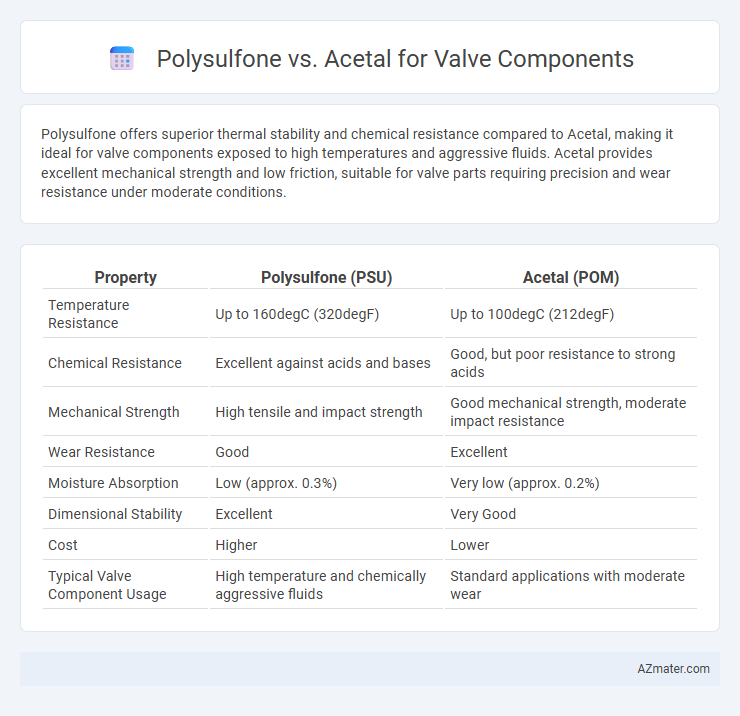Polysulfone offers superior thermal stability and chemical resistance compared to Acetal, making it ideal for valve components exposed to high temperatures and aggressive fluids. Acetal provides excellent mechanical strength and low friction, suitable for valve parts requiring precision and wear resistance under moderate conditions.
Table of Comparison
| Property | Polysulfone (PSU) | Acetal (POM) |
|---|---|---|
| Temperature Resistance | Up to 160degC (320degF) | Up to 100degC (212degF) |
| Chemical Resistance | Excellent against acids and bases | Good, but poor resistance to strong acids |
| Mechanical Strength | High tensile and impact strength | Good mechanical strength, moderate impact resistance |
| Wear Resistance | Good | Excellent |
| Moisture Absorption | Low (approx. 0.3%) | Very low (approx. 0.2%) |
| Dimensional Stability | Excellent | Very Good |
| Cost | Higher | Lower |
| Typical Valve Component Usage | High temperature and chemically aggressive fluids | Standard applications with moderate wear |
Introduction to Valve Component Materials
Valve components require materials with exceptional mechanical strength, chemical resistance, and thermal stability to ensure reliable performance in demanding environments. Polysulfone offers high-temperature tolerance and excellent resistance to steam and harsh chemicals, making it suitable for valves in industrial applications. Acetal, known for its superior dimensional stability and low friction, provides cost-effective durability in precision valve parts where wear resistance is critical.
Overview of Polysulfone
Polysulfone is a high-performance thermoplastic known for its excellent thermal stability, chemical resistance, and mechanical strength, making it suitable for valve components exposed to harsh environments. It maintains dimensional stability at elevated temperatures up to around 150degC, ensuring reliable performance in demanding industrial applications. Compared to acetal, polysulfone offers superior resistance to hydrolysis and oxidation, enhancing durability in fluid control systems.
Overview of Acetal
Acetal, also known as polyoxymethylene (POM), is a high-performance engineering thermoplastic renowned for its excellent dimensional stability, low moisture absorption, and outstanding wear resistance, making it ideal for valve components subjected to mechanical stress and repeated motion. Its high tensile strength and chemical resistance against solvents, fuels, and weak acids ensure durability and reliability in fluid control applications. Compared to polysulfone, acetal offers better machinability and lower friction, which reduces wear and extends the service life of precision valve parts.
Mechanical Strength Comparison
Polysulfone exhibits superior mechanical strength compared to acetal, with higher tensile strength typically around 75 MPa versus acetal's 65 MPa, making it more suitable for high-pressure valve components. Polysulfone also maintains better impact resistance and dimensional stability under elevated temperatures up to 150degC, while acetal begins to degrade near 100degC. The enhanced mechanical durability of polysulfone ensures longer service life and reliability in demanding valve applications where load-bearing capacity is critical.
Chemical Resistance Properties
Polysulfone exhibits superior chemical resistance compared to acetal, particularly against acids, bases, and hot water, making it ideal for valve components exposed to harsh environments. Acetal offers excellent resistance to alcohols and hydrocarbons but is more susceptible to strong acids and oxidizing agents, which can lead to degradation over time. For applications demanding high chemical stability and thermal resistance, polysulfone's robust molecular structure provides enhanced durability and longevity in valve components.
Temperature Tolerance Differences
Polysulfone offers superior temperature tolerance for valve components, maintaining mechanical strength and dimensional stability up to 150degC (302degF), whereas acetal typically withstands continuous use only up to 90degC (194degF). Polysulfone's high heat resistance makes it ideal for applications involving hot fluids or steam, where thermal degradation of acetal could lead to component failure. Selecting polysulfone ensures longer service life and reliability in high-temperature valve environments.
Machinability and Fabrication
Polysulfone offers superior thermal stability and chemical resistance compared to Acetal, making it suitable for valve components exposed to high temperatures and aggressive fluids. Acetal excels in machinability due to its low moisture absorption and dimensional stability, resulting in precise, smooth finishes with minimal tool wear. Fabrication of Acetal is generally more cost-effective and faster, while Polysulfone requires specialized machining conditions to prevent material stress and achieve optimal performance.
Cost and Availability
Polysulfone offers high-temperature resistance and excellent chemical stability but comes at a higher cost compared to acetal, making it less economical for large-scale valve components. Acetal provides good mechanical strength and chemical resistance at a lower price point, with widespread availability due to its common use in automotive and plumbing industries. The cost-effectiveness and broad supply chain of acetal often make it the preferred choice for valve components where budget constraints and part availability are critical.
Common Applications in Valve Design
Polysulfone offers excellent chemical resistance and high-temperature stability, making it ideal for valve components in pharmaceutical and food processing industries. Acetal, known for its superior mechanical strength and low friction, is commonly used in water and HVAC valve designs where durability and precision are critical. Both materials are chosen based on specific performance requirements, with polysulfone favored for aggressive chemical environments and acetal preferred for applications requiring robust wear resistance.
Choosing the Right Material for Your Valve Components
Polysulfone offers excellent thermal stability and chemical resistance, making it ideal for valve components exposed to high temperatures and aggressive fluids. Acetal provides superior dimensional stability and low friction, which enhances precision and wear resistance in mechanical valve parts. Selecting between polysulfone and acetal depends on application-specific requirements such as operating temperature, chemical exposure, and mechanical load to ensure optimal valve performance and longevity.

Infographic: Polysulfone vs Acetal for Valve Component
 azmater.com
azmater.com